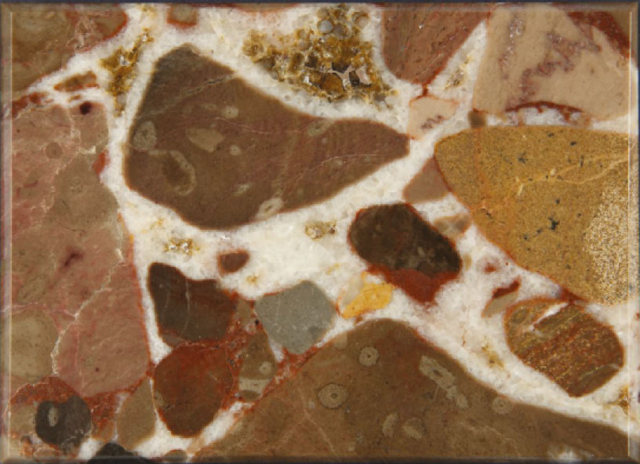PERMIAN CONGLOMERATES

In the previous issue of Kurier Kamieniarski, I started a series of articles about stones from the Świętokrzyski region under the peculiar title “Świętokrzyskie marbles”. The main material mined in the Świętokrzyski region have always been limestones, that is carbonate sedimentary rocks, which, from the petrographic point of view, are not classified as marble as they did not undergo the process of metamorphization. However, like marble, they are easily polished and get a very decorative shine. This similarly applies to Permian conglomerates — also mined in this area — among which “Zygmuntówka” is famous for its crucial role in Polish stone industry.
Permian conglomerates, also called zygmuntowski conglomerates, are exploited in the central part of the Bolechowicki Ridge on Czerwona Góra, formerly known as Jerzmaniec or Góra Jerzmaniecka, to the north and north-east of the Karczówka near Kielce, in the Gałęzice, Jaworznia and Jaźwica quarries. The most famous place of its occurrence and exploitation is the “Zygmuntów” quarry in Czerwona Góra near Chęciny. The rock was formed about 260 million years ago in the Upper Permian period from Devonian pebbles, limestones and dolomites. The binder is calcareous-iron rock dough as well as the calcite binder formed later. The commencement of exploitation is probably related to the exploration and acquisition of lead ore — the galena — in this region.
The name of the quarry — “Zygmuntówka” — comes from the column carved here in 1643, on which stood a statue of Sigismund III Vasa. While still alive, King Sigismund III Vaza ordered the carving of two columns, each of them 38 feet high, on which he intended to place statues in Warsaw. However, this plan was not implemented and it was only his son, Władysław IV, who ordered them to be excavated. During the process of carving, one of the columns broke, and the other stone core, detached from the deposit, was transported to Sandomierz and floated down the Vistula river to Warsaw. It was 11.6 meters long and had about 1 meter in diameter. After processing, it was erected in front of the Royal Castle in Warsaw’s Old Town. After 242 years — in 1885 — the column was dismantled as advanced erosive processes threatened the stability of the site. We can still see its fragments placed next to the Royal Castle today.
 The first core of the zygmuntowski column
The first core of the zygmuntowski column
The Jerzmaniec quarry gets a mention in the inspection of the Chęciny property as early as 1602. In the prosperous period of the 17th century, Italian, Scottish and Flemish masters, as well as Poles and Jews, were involved in stonework in the Chęciny area. In the period 1816-1833, the material was processed in the marble processing plant in Chęciny, and then in the years 1876-1973 (with a few years of a standstill) in the “Marble” area of Kielce. Following the Second World War, in 1950, operation was resumed and finally ended in 1993 as further exploitation would pose a threat for the protected area of the “Raj” cave situated north of the quarry.
The zygmuntowski conglomerate can be easily polished, but it is only used for making internal elements. Due to its heterogeneous structure, it is quite susceptible to the destructive effects of weather conditions. For the same reason, it should not be used for floors or stairs as it wears out unevenly. External architectural details made of the conglomerate lost their polishing within a few years, and the spaces between the individual pebbles eventually began to peel off and crumble.
Besides the Świętokrzyski region, this rock was also used for decoration of numerous objects, including sites in the cities of Krakow and Warsaw.
 Portal in the Cistercian monastery in Jędrzejów made of zygmuntowski conglomerate.
Portal in the Cistercian monastery in Jędrzejów made of zygmuntowski conglomerate.
Source: Kurier kamieniarski
Author: Jerzy Jędrychowski | Published: 28.04.2017
